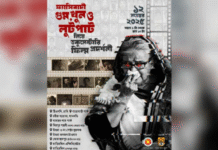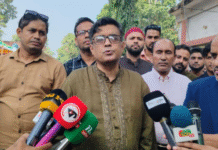42 districts at high risk; hospitals in border dists grapple with rush of patients

On Thursday, the authorities of Chapainawabganj Sadar Hospital increased the number of beds for Covid-19 patients to 30 from 20 to tackle the rush of patients.
As it was not enough, the number of beds had to be raised to 50 yesterday. All the beds, however, were occupied by evening, said Ahnaf Shahriar, a physician at the hospital’s coronavirus unit.
 For all latest news, follow The Daily Star’s Google News channel.
For all latest news, follow The Daily Star’s Google News channel.
“We’ve more patients coming,” he told The Daily Star last night.
Hospitals in five other districts — Satkhira, Chuadanga, Rajshahi, Noakhali, and Bagerhat — were also struggling to accommodate an increasing number of coronavirus patients, said sources at the hospitals.
Except Bagerhat and Noakhali, the four other districts have borders with India.
Health experts and officials believe the situation arose due to the community transmission of the Indian variant (Delta) of the Covid-19 and slack measures to curb the spread of the virus.
The Indian variant has been held responsible recently for the massive surge in Covid-19 cases in India.
According to the weekly analysis of the Directorate General of Health Services (DGHS), these six districts witnessed positivity rates of 30 percent and above from last week until Thursday.
It means every 30 or above number of samples tested came positive there.
The situation in Bagerhat, Noakhali, and Chuadanga were not that serious the previous week, shows the weekly analysis.
The situation in 36 other districts are also alarming as the positivity rate in each district is 10 percent or above.
Under these circumstances, experts have warned that the Covid situation in those districts might worsen further after a week or two as public movement have increased following the resumption of inter-district vehicle movement on May 24.
They warned that the surge in infection will reach the heartland of the country soon.
The fear stemmed from the fact that the overall positivity rate across the country was 11.03 percent yesterday. It was the highest in the last 33 days.
According to the DGHS analysis, the positivity rate was between 20 and 29 percent in 10 districts throughout last week until Thursday. The rate was between 10 and 19 percent in 26 and below 10 in 22 districts, including Dhaka.
Institute of Epidemiology Disease Control And Research (IEDCR) says districts with positive rates of 10 percent and above are considered “high risk” zones, while those with 5-9 percent “medium risk” zones and those below five percent “low risk” zones.
HOSPITALS OVERBURDENED
The number of patients in hospitals in the six districts — Chapainawabganj, Satkhira, Chuadanga, Rajshahi, Noakhali, and Bagerhat — has been on the rise.
With no or limited capacity to treat critical Covid-19 patients, the hospital authorities in the border districts referred such patients to medical college hospitals in Rajshahi, Khulna and Satkhira.
In the 250-bed Chapainawabganj Sadar Hospital, the Covid unit has no ICU facility. It can’t treat patients requiring oxygen more than 20 litres per minute.
So, the hospital authorities every day have to refer one or two critical patients to Rajshahi Medical College Hospital 70km away, said doctors there.
Chapainawabganj reported 55 percent positivity rate on Friday.
In the past 24 hours till 8:00am yesterday, 43 Covid-19 patients died. Of those, the highest 12 were in Rajshahi division while five were in Khulna, shows DGHS data.
The number of deaths in Rajshahi and Khulna has been on the rise for last two weeks.
In the past 13 days, 101 patients died in the Covid-19 unit of Rajshahi Medical College Hospital, said hospital sources.
The RMCH authorities have added another ward to the 232-bed Covid-19 unit to tackle the high number of patients coming in.
Noakhali Civil Surgeon Masum Iftekhar said they arranged a makeshift hospital in a stadium in the Noakhali municipality area for coronavirus patients as their number was going up.
“Ten days ago, we had 20 patients daily on an average. The number has now gone up to 30. If the transmission continues, people from nearby districts might come here seeking treatment,” he said.
To put the brakes on increasing number of Covid cases, the Noakhali district administration has put the municipality areas and six nearby unions under lockdown from 6:00am yesterday to 12:00pm on June 12.
‘TRANSMISSION MAY SPIKE’
Experts have warned of another spike in Covid cases after a week or two due to the withdrawal of movement restriction and people’s reluctance to adhere to the health safety guidelines.
“It seems that after a week the condition of the entire country will turn the same as that of the border districts. It is worrisome. We should activate movement restrictions immediately. Otherwise, we might lose many lives,” Mahbuba Zamil, head of virology at the Institute of Public health, told The Daily Star yesterday.
She said the previous spike in April and May was tamed after restrictions were imposed on inter-district transport for a month since April 5.
“People left and returned Dhaka over the Eid. So the transmission continued. Since there is no restrictions in place now, the transmission rates are likely to go up again,” she said.
She also said the transmission rate in Dhaka was now stable, but it may spike soon.
Echoing her statement, Mushtuq Hussain, a consultant of the IEDCR, said the Delta variant may be responsible for the recent spike in cases.
He said many returned from India with the variant and managed to go to different districts dodging law enforcers’ surveillance.
“If strict measures are not taken, the situation in other districts, including the capital, might turn the same as in the border districts. It may happen in a week or two,” he said.
IS DELTA VARIANT RESPONSIBLE?
A study published by the IEDCR on Thursday suggested that the Delta variant, popularly known as the Indian variant, was spreading at the community level.
Since the first case of the Indian variant was detected in the country on May 8, the IEDCR and the Institute for Developing Science and Health Initiatives (ideSHi) have completed genome sequencing of 50 samples of coronavirus.
Among the Delta variant infected patients, 14 had not gone abroad and did not come in contact with people with travel history, which indicates that the community transmission of Delta variant exists in Bangladesh.
Mahbuba Zamil said, “After we had the UK variant, we imposed restrictions on movement and the transmission came down. The Indian variant is a threat, but it can also be checked if some measures are taken.”
Mushtuq Hussain said the same.
The country reported the second wave of Covid in the second week of March. After the government imposed movement restrictions from April 5, the transmission started going down steadily. The positivity rate reached the lowest — seven percent — in mid-May.
With restrictions eased, the transmission started rising again from the third week of May.










